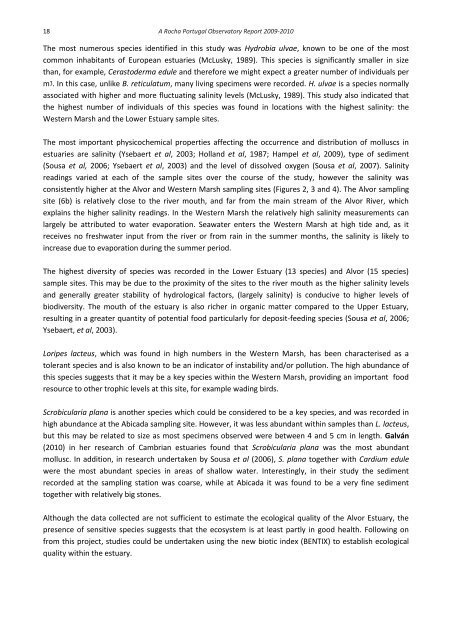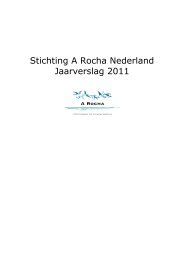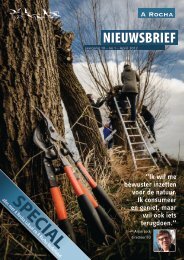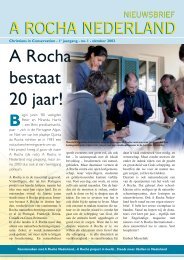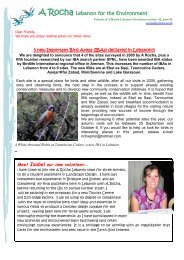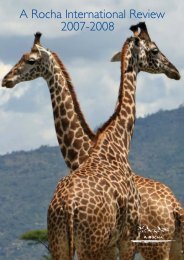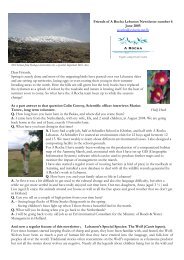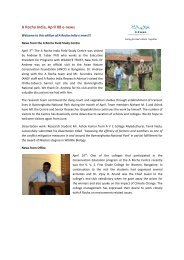A Rocha Portugal Observatory Report 2009-2010
A Rocha Portugal Observatory Report 2009-2010
A Rocha Portugal Observatory Report 2009-2010
You also want an ePaper? Increase the reach of your titles
YUMPU automatically turns print PDFs into web optimized ePapers that Google loves.
18 A <strong>Rocha</strong> <strong>Portugal</strong> <strong>Observatory</strong> <strong>Report</strong> <strong>2009</strong>-<strong>2010</strong><br />
The most numerous species identified in this study was Hydrobia ulvae, known to be one of the most<br />
common inhabitants of European estuaries (McLusky, 1989). This species is significantly smaller in size<br />
than, for example, Cerastoderma edule and therefore we might expect a greater number of individuals per<br />
mᶾ. In this case, unlike B. reticulatum, many living specimens were recorded. H. ulvae is a species normally<br />
associated with higher and more fluctuating salinity levels (McLusky, 1989). This study also indicated that<br />
the highest number of individuals of this species was found in locations with the highest salinity: the<br />
Western Marsh and the Lower Estuary sample sites.<br />
The most important physicochemical properties affecting the occurrence and distribution of molluscs in<br />
estuaries are salinity (Ysebaert et al, 2003; Holland et al, 1987; Hampel et al, <strong>2009</strong>), type of sediment<br />
(Sousa et al, 2006; Ysebaert et al, 2003) and the level of dissolved oxygen (Sousa et al, 2007). Salinity<br />
readings varied at each of the sample sites over the course of the study, however the salinity was<br />
consistently higher at the Alvor and Western Marsh sampling sites (Figures 2, 3 and 4). The Alvor sampling<br />
site (6b) is relatively close to the river mouth, and far from the main stream of the Alvor River, which<br />
explains the higher salinity readings. In the Western Marsh the relatively high salinity measurements can<br />
largely be attributed to water evaporation. Seawater enters the Western Marsh at high tide and, as it<br />
receives no freshwater input from the river or from rain in the summer months, the salinity is likely to<br />
increase due to evaporation during the summer period.<br />
The highest diversity of species was recorded in the Lower Estuary (13 species) and Alvor (15 species)<br />
sample sites. This may be due to the proximity of the sites to the river mouth as the higher salinity levels<br />
and generally greater stability of hydrological factors, (largely salinity) is conducive to higher levels of<br />
biodiversity. The mouth of the estuary is also richer in organic matter compared to the Upper Estuary,<br />
resulting in a greater quantity of potential food particularly for deposit-feeding species (Sousa et al, 2006;<br />
Ysebaert, et al, 2003).<br />
Loripes lacteus, which was found in high numbers in the Western Marsh, has been characterised as a<br />
tolerant species and is also known to be an indicator of instability and/or pollution. The high abundance of<br />
this species suggests that it may be a key species within the Western Marsh, providing an important food<br />
resource to other trophic levels at this site, for example wading birds.<br />
Scrobicularia plana is another species which could be considered to be a key species, and was recorded in<br />
high abundance at the Abicada sampling site. However, it was less abundant within samples than L. lacteus,<br />
but this may be related to size as most specimens observed were between 4 and 5 cm in length. Galván<br />
(<strong>2010</strong>) in her research of Cambrian estuaries found that Scrobicularia plana was the most abundant<br />
mollusc. In addition, in research undertaken by Sousa et al (2006), S. plana together with Cardium edule<br />
were the most abundant species in areas of shallow water. Interestingly, in their study the sediment<br />
recorded at the sampling station was coarse, while at Abicada it was found to be a very fine sediment<br />
together with relatively big stones.<br />
Although the data collected are not sufficient to estimate the ecological quality of the Alvor Estuary, the<br />
presence of sensitive species suggests that the ecosystem is at least partly in good health. Following on<br />
from this project, studies could be undertaken using the new biotic index (BENTIX) to establish ecological<br />
quality within the estuary.


